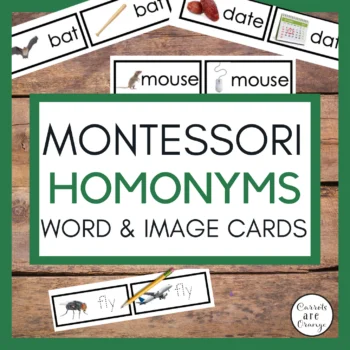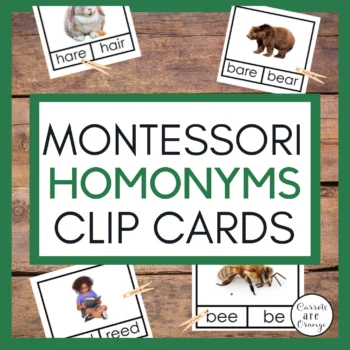Homonyms can be a tricky concept for students to grasp, but with the right activities and resources, they can become experts in no time! From games to worksheets, there are plenty of creative ways to make learning about homonyms fun and engaging for your students. Discover some of the best ideas and resources here.

Homonym Activities for Kids
What are homonyms?
Homonyms are words that have the same pronunciation or spelling but have different meanings. They can create confusion and ambiguity in language, as they sound or look alike but convey distinct concepts.
- Homonyms can be categorized into two main types:
homophones - homographs
Homophones: These are words that are pronounced the same but may have different spellings and meanings. Examples include:
- “Two” and “too”: Two refers to the number 2, while too means “also” or “excessively.”
- “Their,” “there,” and “they're”: Their indicates possession, there refers to a place, and they're is a contraction of “they are.”
- “Flour” and “flower”: Flour is a powdery substance used in baking, while a flower is a plant's reproductive structure.
Homographs: These are words that have the same spelling but can have different pronunciations and meanings. Examples include:
- “Bow”: It can refer to a knot tied with two loops or to bend forward. These have different pronunciations but the same spelling.
- “Lead”: It can be pronounced as “led” (past tense of lead) or “leed” (a soft, heavy metal).
- “Tear”: It can be pronounced as “teer” (a drop of liquid from the eyes) or “tair” (to rip or shred).
Understanding the context and using clues from the surrounding words or sentences is important to interpret the intended meaning of homonyms correctly.
Homonyms List
- bat, bat
- band, band
- rock, rock
- clip, clip
- date, date
- fly, fly
- point, point
- scale, scale
- pitcher, pitcher
- ruler, ruler
- bark, bark
- watch, watch
- wave, wave
- ship, ship
- mouse, mouse
- pen, pen
- chest, chest
- bow, bow
- trunk, trunk
- bank, bank
- chip, chip
- ring, ring
- duck, duck
- file, file
- tie, tie
- left, left
- palm, palm
- great, grate
- cell, sell
- pole, poll
- pear, pair
- buy, bye
- beat, beet
- flour, flower
- bury, berry
- sale, sail
- chili, chilly
- board, bored
- ate, eight
- blue, blew
- plane, plain
- scent, cent
- rose, rows
- hair, hare
- mail, male
- bear, bare
- see, sea
- son, sun
- doe, dough
- one, won
- meet, meat
- toe, tow
- wait, weight
- medal, metal
- right, write
- fur, fir
- peace, piece
- peak, peek
- rays, raise
- stare, stair
- tea, tee
- reed, read
- waist, waste
- rain, rein
- i, eye
- dear, deer
- feat, feet
- forth, fourth
- hole, whole
- hear, here
- groan, grown
- so, sew
- hall, haul
- be, bee
- knight, night
- no, know
- new, knew
- brake, break
- flu, flew
- ore, oar
- wail, whale
- through, threw
- sore, soar
- knead, need
- hi, high
Download the list by clicking on the image below:
#1 – Homonym Match-Up Game
One fun activity to help students learn about homonyms is the Homonym Match-Up Game. Create cards with homonyms on them (e.g. “flower” and “flour”) and have students match them up.
You can also make it more challenging by including multiple sets of homonyms and having students match them all up correctly. This game is a great way to reinforce the concept of homonyms while also improving memory and concentration skills.
#2 – Homonym Scavenger Hunt
Another fun activity to teach homonyms is a scavenger hunt. Create a list of homonyms and have students search for objects that represent each word on the list. For example, if the list includes “bear” and “bare,” students could find a teddy bear and a bare tree branch.

This activity encourages creativity and critical thinking while also reinforcing the concept of homonyms. You can also make it a competition by seeing which team can find all the objects on the list first.
#3 – Homonym Clip Cards
This educational resource combines the Montessori approach with the study of homonyms, making language learning engaging and interactive.
This unique set of clip cards is specially designed to help students master homonyms, a vital aspect of grammar and vocabulary. With vibrant images and carefully selected homonyms, these cards provide an exciting opportunity for students to explore the world of words and expand their language skills.
Each card features a beautiful image of a homonym and two name options for the homonym. The child's job is to clip (or circle with a dry-erase marker) the appropriate homonym to match the image, making it easy for students to grasp the concept and distinguish between different meanings.
#4 – Homonym Pictionary
Homonym Pictionary is a fun and interactive way to reinforce the concept of homonyms. Divide the class into teams and give each team a list of homonyms. One member of each team will draw a picture of one of the homonyms while their team tries to guess which homonym it represents.
For example, if the homonym is “flower” and “flour,” the student could draw a picture of a flower and a bag of flour. This activity encourages teamwork, creativity, and critical thinking while also reinforcing the concept of homonyms.
#5 – Homonym Crossword Puzzle
Another great activity to reinforce homonyms is a crossword puzzle. Create a crossword puzzle with homonyms as clues and have students fill in the correct homonym in the corresponding boxes.
Download a FREE Homonym Crossword Puzzle Here
This activity not only reinforces the concept of homonyms but also helps with spelling and vocabulary. You can find pre-made homonym crossword puzzles online or create your own using a crossword puzzle maker tool.

#6 – Homonym Charades
Homonym charades are a fun and interactive way to reinforce homonyms in the classroom. Divide the class into teams and give each team a list of homonyms. One student from each team will act out one of the homonyms while their team tries to guess which homonym they are acting out.
This activity not only reinforces homonyms but also encourages teamwork and communication skills. You can find pre-made homonym lists online or create your own based on the level and age of your students.



